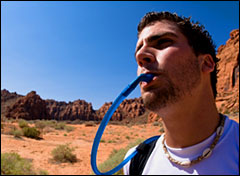Dear Umbra,
Recently, I’ve started to try to avoid plastics (especially plastic water bottles). For Christmas, my brother gave me a Camelbak-type water bottle. How safe is this? I assume it’s as bad as most plastic water bottles.
Timothy Kearney
Issaquah, Wash.
Dearest Timothy,
Gifting quandary alert.

But does it suck?
Photo: iStockphoto
Not all plastic water bottles are equal. In a larger context of avoiding plastic, we may occasionally find ourselves with a plastic bottle that is handy and use it for a while. There are certain exceptions: We should try to completely avoid polyvinyl chloride, PVC, which is #3; and the same with Lexan/polycarbonate (#7, which may say ‘other’ on the bottle), renowned for leaching the endocrine disruptor bisphenol A. Avoid these for your own health as well as on behalf of larger environmental disruption.
Other numbered plastics are less dire, with caveats. Bottle caveats relate to plastic degradation and microbial contamination. Don’t use hot liquids in plastic bottles; don’t reuse milk or juice bottles, since you won’t be able to get them clean and the microbes will grow; and don’t use scratched or damaged bottles for the same reasons.
Back to #7, which in hard water bottles made by Camelbak and Nalgene has meant the evil BPA-leaching polycarbonate. Camelbak, according to various press releases, has redesigned its hard water bottles to be a co-polyester rather than the polycarbonate. The trick for your Christmas present, if indeed you got a hard water bottle, is that I’m not sure the co-polyester bottles are yet out, since they seem to be scheduled for early 2008. You’ll have to call Camelbak or look on the bottom of the bottle. Or just go straight to REI and exchange the thing for a metal bottle. You could also exchange it for socks, snacks, or a ski pole.
The plastic water bags made by Camelbak, Platypus, and others are a separate matter of interest. Please follow all the basic plastic protocols with these vessels, including cleaning them often and throwing them out when they get skanky — and you know what I’m talking about, people. Those tubes are mold havens. Do as I say, not as I did. Ick. From what I can find, the Platypus bags are polyethylene (this would be #1, I assume) and the Camelbak bags are polyurethane with a polyethylene lining. So these are better than Lexan. I know they are incredibly handy when hiking, biking, and skiing — just treat them with care and they should have a long, skank-free life, rather than a short, disposable life.
Baggily,
Umbra

